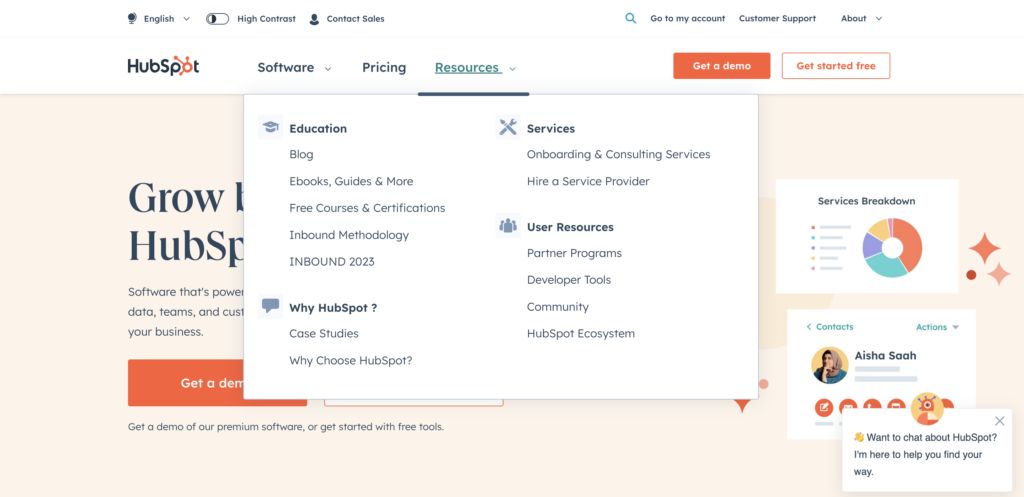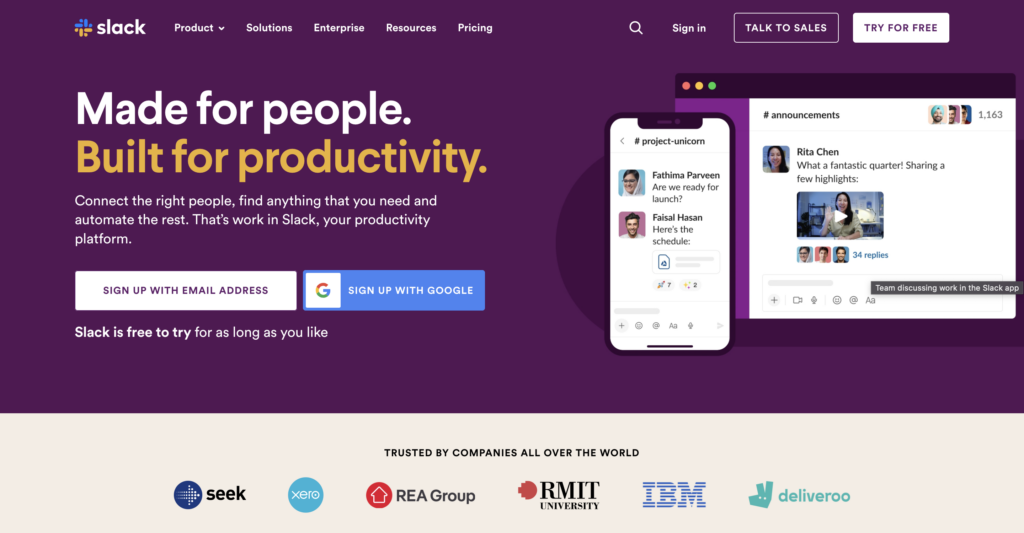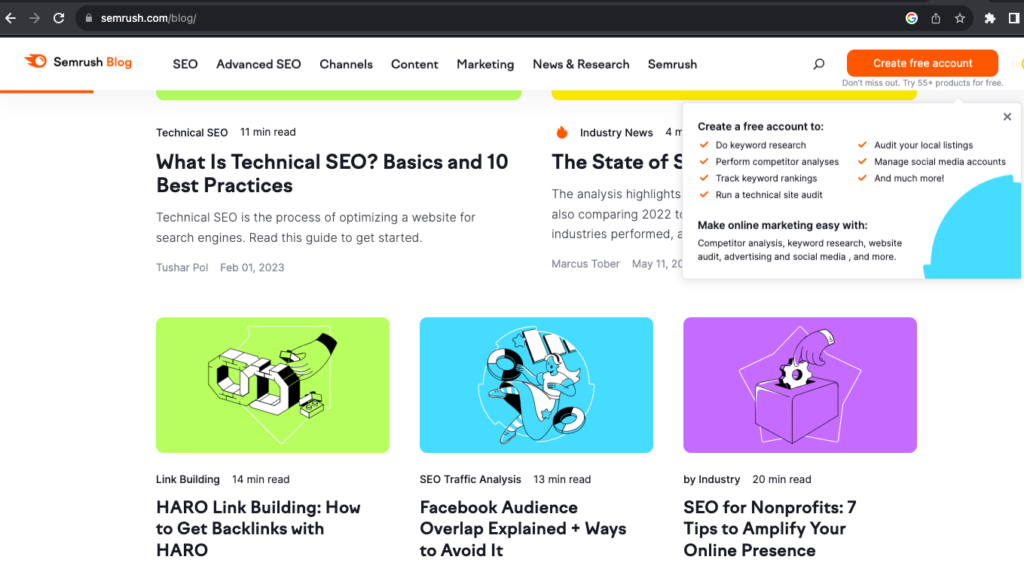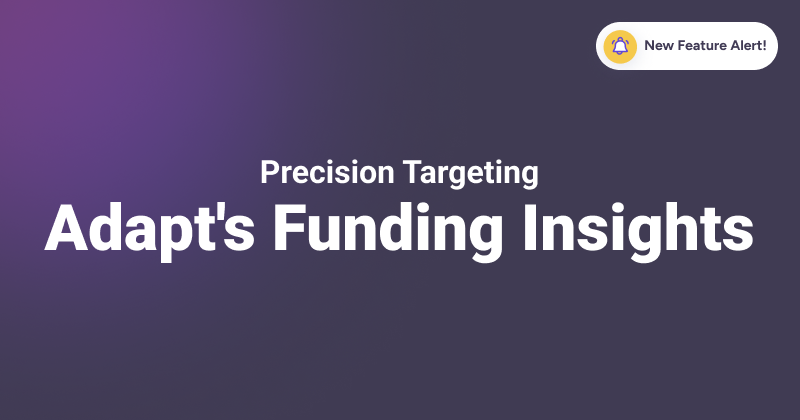Inbound sales represent a customer-centric approach to selling products or services. Unlike outbound sales, which involve cold calls and external outreach, inbound sales strategies aim to attract potential customers organically. This methodology revolves around the idea of drawing customers in by offering them something valuable, whether it’s insightful content, solutions to their problems, or relevant expertise. Inbound sales recognize the changing dynamics of how people buy in today’s digital age, where customers prefer to research and make informed decisions on their own terms.
B2B organizations have effectively, over the years, harnessed the potential of inbound sales. An exemplary example would be Talent Cue. In 2013, the brand was aiming to create brand awareness in Spanish. They conquered this by creating blogs, ebooks, and guides, conducting webinars, setting up forms across the website, and maintaining a robust distribution calendar on social media. They used HubSpot as a CRM to track user engagement and reported an increase of 194% in leads and 291% in revenue.
Inbound sales are the outcome of well-crafted strategies that provide value, build trust, and establish meaningful connections with potential customers. Central to this approach is content marketing, freemium model, SEO, social media marketing, and brand awareness. In this article, we will discuss 20 such inbound sales strategies, but before we dive deep into that, it is crucial to understand how these strategies benefit the organization.
Benefits of Inbound Sales Strategies
Inbound sales are advantageous because they attract potential customers organically through valuable content and engagement, resulting in higher-quality leads and improved conversion rates. This approach fosters long-term customer relationships and reduces the need for cold outreach. Here’s a more detailed breakdown of the benefits of inbound sales strategies :
- Targeted Lead Generation: Inbound strategies attract potential customers who are actively searching for solutions, aiding in high-quality lead generation. For instance, creating informative blog posts about common pain points in your industry can attract prospects actively seeking solutions.
- Cost-Effective: Inbound strategies tend to be more cost-effective than traditional outbound methods. By producing valuable content and optimizing it for search engines (SEO), you can consistently generate leads without the high costs associated with cold calling or advertising.
- Builds Credibility and Trust: Providing helpful, well-researched content establishes your website as an authority in your niche. When prospects find valuable information on your blog or social media, they are more likely to trust your product or service.
- Long-term Relationship Building: Inbound strategies focus on nurturing leads over time. Through email marketing, drip campaigns, and personalized content, you can maintain a relationship with potential customers until they are ready to make a purchase.
- Sales and Marketing Alignment: Success in inbound sales is a combined effort of sales and marketing. Marketing provides sales with qualified leads generated through content and nurtures them until they are sales-ready. In return, sales shares valuable insights from customer interactions, helping marketing refine their content and targeting. This synergy fosters a shared understanding of customer needs and a unified approach, ultimately driving more effective lead generation and conversion.
- Higher conversions: These strategies lead to higher conversion rates by attracting pre-qualified leads who are actively seeking solutions, fostering trust through valuable content, and offering a more personalized and less intrusive buying experience. This approach aligns with the prospect’s needs and preferences, ultimately increasing the likelihood of conversion.
- Data-Driven Decision-Making: Inbound sales strategies are highly measurable. You can track key metrics such as website traffic, conversion rates, and customer engagement. These insights enable data-driven decision-making and allow you to refine your strategies for better results.
- Adapts to Buyer Behavior: Inbound strategies adapt to how modern buyers research and make purchasing decisions. Today, customers prefer to educate themselves before reaching out to a salesperson. By providing the information they need, you align with their buying journey.
- Scalability: Once you’ve created valuable content, it can continue to generate leads and build brand awareness over time, often with minimal ongoing effort. This scalability is particularly beneficial for startups aiming for rapid growth.
Incorporating these strategies into your content marketing efforts can enhance lead generation, brand credibility, and overall growth.
19 best inbound sales strategies
Most inbound sales strategies focus on creating compelling and helpful content, strong SEO strategies, building your online brand presence, and strengthening user relationships. Here are 20 such strategies to help you boost your inbound sales effectively.
1. Target your inbound leads strategically
Targeting inbound leads strategically is an important aspect of driving growth and success for B2B companies. By understanding the target audience and tailoring marketing efforts accordingly, you can effectively convert inbound leads into loyal customers.
To create a robust strategy for targeting inbound leads, you should start by defining their ideal customer profile (ICP) and understanding their target audience’s characteristics, preferences, and pain points. You should then focus on creating valuable and informative content that addresses these pain points and positions itself as a trusted resource.
Let’s take the example of HubSpot, which has successfully implemented this strategy. HubSpot has built a robust content engine for targeting their inbound leads by offering valuable content and resources that cater to their audience’s pain points. In addition to content marketing, HubSpot also employs lead nurturing techniques to engage with their inbound leads effectively.

2. Leverage the power of data to drive insights
By effectively collecting, analyzing, and interpreting data, you can uncover valuable insights to boost your sales and marketing strategies. Data can provide valuable information about customer behavior, preferences, and pain points, enabling companies to personalize their approach and deliver targeted messaging.
To leverage the power of data, you should start by implementing robust analytics tools to gather data from various sources, such as website traffic, user interactions, and customer demographics. By tracking and analyzing this data, you can gain a deep understanding of your target audience, identify patterns, and make data-driven decisions.
Have a look at Salesforce as an example. Through its CRM platform, Salesforce captures and analyzes customer data to gain insights into customer preferences, buying behaviors, and needs. This data-driven approach allows them to tailor their sales and marketing strategies to individual customers or specific segments, resulting in improved lead generation, conversion rates, and customer satisfaction.
3. Audience segmentation to deliver personalized content
Segmenting your audience is a powerful strategy for driving inbound sales. With distinct segments, you can tailor your messaging and content to resonate with each niche’s specific needs and preferences. Personalized content enhances engagement, builds trust, and increases the likelihood of conversion.
You can make segments in your audience based on the following aspects:
- Industry
- Company Size
- Geographical Location
- Persona or Role
- Customer Lifecycle Stage
- Pain Points or Use Cases
- Affordability
4. Map out your buyer journey for a better understanding
Understanding the touchpoints in between initial awareness to purchase decisions provides valuable insights for optimizing sales and marketing efforts. By mapping out the buyer journey, you can identify key stages, such as awareness, consideration, and decision-making, and align their sales and marketing activities accordingly. This strategy allows you to deliver the right messages, content, and offers at each stage, increasing the chances of conversion.
For example, a customer relationship management (CRM) company can map out their buyer journey as follows:
Awareness Stage:
In the awareness stage, potential customers may search for information on CRM benefits and solutions. The company can provide educational blog posts, eBooks, or videos that highlight the importance of CRM and showcase its value.
Consideration Stage:
In the consideration stage, where potential customers are evaluating different CRM options, the company can offer comparative whitepapers, case studies, or webinars that demonstrate their product’s unique features and advantages.
Decision-making Stage:
Finally, in the decision-making stage, the company can provide personalized demos, free trials, or consultations to help potential customers make an informed choice.
This strategic approach leads to a more efficient and targeted sales process.
5. Simplify the process for your prospects
British business magnate Richard Branson has said, “Complexity is your enemy. Any fool can make something complicated. It is hard to keep things simple.” This statement is a testament to inbound sales strategies.
Complexity can be a major roadblock for potential customers. Making it easy for prospects to understand and engage with your product or service is important. You should focus on providing a seamless and intuitive user experience.
This starts with designing a user-friendly website that clearly communicates the value proposition and benefits of the product. Simplifying the onboarding process is also essential. Offering clear and concise instructions, guided tutorials, and responsive customer support helps prospects navigate with ease.
An exemplary SaaS company that simplifies the process for prospects is Slack. From the moment a prospect lands on Slack’s website, the messaging and design guide them towards understanding how the platform simplifies communication and boosts productivity.
Slack makes its prospects experience the use case of the product, which increases the chance for conversion. The interactive design and use of media on the site make it very clear what Slack does and how it can help the prospect.

6. Review and refine your messaging and tactics regularly
Delivering a strong message with a proven tactic to the wrong audience leads to no results. All three aspects message, audience, and tactics are crucial when framing a messaging strategy. Organizations must review and refine their messaging and tactics in a timely manner.
By constantly reviewing your messaging and tactics, you can identify areas for improvement and make necessary adjustments. This includes assessing the clarity and alignment of your value proposition, evaluating the effectiveness of different communication channels, and analyzing the response and engagement of your target audience.
Jill Rowley, a renowned sales strategist and social selling evangelist states, “Sales success comes down to delivering the right message to the right person at the right time in the right way.” Regularly reviewing and refining your messaging and tactics ensures that your communication remains compelling, resonates with your target audience, and effectively addresses their pain points. By staying agile and responsive to market dynamics, B2B companies can maintain a competitive edge and maximize their inbound sales opportunities.
7. Align your words with your actions consistently
Remember, actions speak louder than words, and by consistently delivering on your promises, you demonstrate your commitment to customer success and differentiate yourself in a competitive market.
Aligning your words with your actions consistently is a fundamental strategy for organizations to establish trust and credibility and foster strong customer relationships. It involves ensuring that the promises and commitments made through your marketing and sales messaging are consistently delivered throughout the entire customer journey. This strategy ensures that your customers receive a seamless experience, from their initial interactions with your product to their ongoing usage of your solution.
Follow this 5 step actionable blueprint that can help you effectively align your words with your actions:
- Define your brand values
- Integrate it your messaging
- Train your team
- Deliver on promises
- Solicit and act on feedback
8. Proactively engage with your leads throughout their journey
Lead nurturing strategies are as important as lead generation strategies in inbound marketing. By actively reaching out and providing valuable support, information, and personalized assistance, you can nurture leads and guide them toward making informed decisions.
Implementing actionable tactics like personalized email campaigns, audience segmentation, lead scoring, and marketing automation for lead nurturing leads to successful conversions and long-term customer relationships.
9. Build a high-performing team dedicated to inbound sales
A high-performing inbound sales team can significantly impact revenue generation and customer acquisition by leveraging their expertise and aligning their efforts with the company’s overall sales and marketing strategies. Building a high-performing team entails assembling a group of talented individuals who possess the right skills, mindset, and expertise to effectively engage with leads, nurture relationships, and close deals.
Here are the 7 key features of a high-performing inbound sales team:
- Expertise in inbound sales methodology
- Strong communication and relationship-building skills
- In-depth product knowledge
- Collaborative mindset
- Adaptability and continuous learning
- Data-driven approach
- Result-oriented attitude
10. Invest in cost-effective software solutions
Cost-effective software solutions and technologies can help companies streamline their processes. It enhances productivity and improves overall efficiency of their inbound sales and marketing campaigns while keeping costs under control.
Inbound marketing and sales campaigns can’t completely succeed without utilizing advanced softwares. From marketing, communication, automation and analytics, there are various points when a company requires a software solution. To effectively support inbound sales and marketing, companies should consider investing in these 6 types of software:
- Customer Relationship Management (CRM) Software
- Marketing Automation Software
- Content Management System (CMS)
- Analytics and Reporting Tools
- Collaboration and Communication Tools
- Project Management Tool
It’s essential to carefully assess the requirements of the team and choose tools that align with your goals and budget.
11. Establish yourself as a trusted thought leader in your industry
Establishing yourself as a trusted thought leader in your industry is a powerful inbound sales strategy. By positioning yourself as an authority in your field, you can attract potential customers, build credibility, and ultimately drive sales.
To become a thought leader in your specific industry, consider following these 6 steps:
- Identify your niche.
- Stay updated.
- Create valuable content.
- Engage with your audience.
- Network and collaborate.
- Speak at industry events.
SEMrush tool is a perfect example of this. Through its blogs, webinars, and a dedicated section for SEO NEWS and research, it has aced how content marketing aids inbound sales. The landing page also offers a clear CTA to create a ‘Free Account’ while listing down the tool’s features. Its a win-win.

12. Harness the potential of social media platforms
Social media marketing provides a powerful channel to engage with potential leads, build brand awareness, and drive conversions. By creating a strong social media presence, you can establish credibility, foster relationships, and generate quality leads. To establish yourself as a brand on social media and implement robust social media marketing tactics, consider the following 10 actions:
- Define your target audience
- Develop a content strategy
- Optimize your profiles
- Engage and interact
- Utilize visual content
- Leverage user-generated content
- Monitor and analyze
- Experiment with paid advertising
- Collaborate with influencers
- Stay updated
Don’t limit your company’s online visibility only to Facebook, Instagram, LinkedIn and Twitter when it comes to social media marketing in the B2B segment. There are a large number of social media platforms that can help you connect with the right target audience. To leverage social media effectively, utilize the following 7 platforms in addition to Facebook, Instagram, Twitter & LinkedIn:
- Quora
- SlideShare
- Tumblr
- Telegram
- Growth Hackers
13. Forge mutually beneficial co-marketing partnerships
Have you seen HubSpot partnering with Canva, a popular graphic design platform? This partnership showcased the value of combining marketing expertise with design tools, attracting both HubSpot and Canva users to engage with the content. Long story short, forging mutually beneficial co-marketing partnerships is a powerful inbound sales strategy. By collaborating with complementary brands, you can expand your reach, tap into new audiences, and drive inbound sales.
Also, a major example of a co-marketing partnership is Salesforce and Google. This collaboration resulted in joint marketing campaigns. The campaign highlighted the benefits of integrating data and insights from both platforms, driving interest and generating leads for both companies.
Here are 5 key aspects to consider while choosing your co-marketing partner brand:
- Identify complementary brands
- Assess shared goals and values
- Define mutual benefits
- Plan joint marketing campaigns
- Establish measurement metrics
14. Personalize every interaction with your leads and customers
By tailoring your communications and experiences to individual preferences and needs, you can build stronger relationships, increase engagement, and drive conversions. For instance, imagine a sales enablement tool that helps increase deal velocity. When interacting with a lead, they can personalize the interaction by adding personalized talking points to the communication.
They can provide relevant case studies or success stories of similar customers and their industries to demonstrate the software’s effectiveness in solving their unique challenges. This personalization creates a sense of understanding and trust and demonstrates the company’s commitment to meeting the lead’s specific needs.
A real-world example is Amazon, which excels in personalization through its recommendation engine. By analyzing user behavior and purchase history, Amazon delivers personalized product recommendations, emails, and offers, resulting in higher customer engagement and increased sales.
Amazon closely watches and records the users’ activity throughout the wide range of products. Then with the help of algorithms, it analyzes these activities and shows products in the recommendations that have a high chance of being purchased by the user.
15. Nurture and re-engage prospects with a well-defined sales funnel
To develop and define an effective sales funnel, start by identifying your target audience and understanding their pain points. Create compelling content and offers that address these pain points and attract prospects to your website. Once they are on your site, capture their contact information through lead generation forms or opt-ins.
An excellent example of a company that has successfully developed a sales funnel to nurture and re-engage prospects is MailChimp. As prospects engage and show interest, MailChimp’s sales team follows up with personalized emails and offers, guiding them through the funnel toward a sales conversation. To guarantee similar success, you can follow these 10 steps to define a sales funnel for the re-engagement of prospects:
- Identify your target audience
- Understand customer pain points
- Create compelling content
- Capture leads
- Segment your prospects
- Nurture prospects with targeted content over email, SMS, etc.
- Gradually introduce sales-oriented messages
- Monitor engagement and readiness
- Provide easy contact options
- Continuously optimize and refine
16. Optimize your lead nurturing tactics for better results
Optimizing your lead nurturing tactics can take your inbound sales to the next level. Lead nurturing optimization involves refining and improving the processes and strategies used to engage and nurture leads throughout the buyer’s journey. By optimizing these tactics, companies can increase conversion rates, shorten B2B sales cycles, and ultimately drive more revenue. To optimize your own lead nurturing tactics, consider implementing these 7 practical strategies:
- Segmentation: Segment B2B leads based on characteristics, behavior, or engagement level.
- Personalization: Customize your messages and content to make them more relevant and personalized for each individual lead.
- Marketing automation: Automate repetitive tasks, such as sending emails, scheduling follow-ups, or tracking lead engagement to ensure consistent engagement.
- Lead scoring: Have a lead scoring strategy to ensure that your leads are qualified and you have the priorities for different leads. Adapt an effective lead qualification process so that you focus only on the most qualified ones.
- A/B testing: Continuously test different variations of your nurturing tactics, such as subject lines, call-to-action buttons, or email templates. Then go ahead with the most effective approaches.
- Multichannel approach: Reach out to your leads through various channels, such as email, social media, webinars, or personalized landing pages.
- Continuous tracking and analysis: Monitor key metrics, such as open rates, click-through rates, or conversion rates, to measure the effectiveness of your lead nurturing tactics.
17. Foster strong relationships with your existing customers
Strong relationships ensure long-term revenue generated from the same customers. A strong customer relationship means building trust, providing exceptional support, and delivering ongoing value to your customers beyond the initial sale. Research shows that existing customers are valuable assets for businesses, as they contribute significantly to revenue growth. As per Bain & Company, customer retention rates are so significant and a retention rate of 5% can help companies yield a profit of more than 25%.
To foster strong relationships with your existing customers, consider implementing these 7 strategies:
- Regular communication
- Provide exceptional customer support
- Offer to educate your customer and provide resources.
- Implement a customer success program
- Seek customer feedback
- Build a customer community
- Reward customer loyalty
18. Continuously analyze and optimize your inbound sales process
Continuous analyzing and optimizing your inbound sales process can enhance the results you get through sales campaigns. By closely examining key metrics and identifying areas for improvement, you can enhance the effectiveness and efficiency of your sales process, ultimately leading to increased conversions and revenue.
To analyze your inbound sales process, closely monitor and evaluate these 5 metrics:
- Conversion rates at each stage.
- Lead quality and source.
- Sales cycle length.
- Customer acquisition cost (CAC).
- Customer lifetime value (CLTV).
By analyzing and optimizing your inbound sales process, you can enhance the efficiency, effectiveness, and overall performance of your sales efforts, resulting in increased conversions, revenue, and business growth.
To optimize your inbound sales process, consider these 7 actionable steps:
- Map out the customer journey.
- Implement automation and technology.
- Conduct A/B testing.
- Collaborate between sales and marketing teams.
- Implement lead scoring.
- Provide ongoing sales training.
- Monitor and iterate.
19. Prioritize ongoing training and development for your sales team
A well-trained sales team is equipped with the knowledge, skills, and techniques needed to effectively engage prospects, address their pain points, and close deals. Providing training not only enhances their abilities but also boosts their confidence, motivation, and job satisfaction. According to a study by the Sales Management Association, companies that invest in sales training and development experience a 50% higher win rate and 24% greater revenue growth compared to those that do not.
To empower your sales team, consider providing these 8 trainings:
- Product and industry knowledge.
- Sales techniques and methodologies.
- Sales enablement.
- Buyer persona and empathy training.
- Communication and relationship-building skills.
- Sales technology and tools.
- Role-playing and scenario-based training.
- Continuous learning and coaching.
Inbound sales strategies are the key to driving success and growth for B2B organizations. These 20 actionable strategies can transform your sales approach and generate remarkable results. From targeting your inbound leads strategically to nurturing strong relationships with existing customers, these strategies are essential for building a sustainable and thriving business. The journey to inbound sales excellence starts now – it’s time to take action and revolutionize your sales approach.
Finally, here are the 2 key takeaways for you to start your journey of developing a robust inbound sales strategy:
- Know your target audience in a very, very deep manner. From what they have (problems) and what they search for (consultancy) to what they want (solutions).
- Have everything planned on your side. From what you can give away (content), what you are going to do (strategy), how you are going to treat (nurturing), how you are going to interact (communication), how you are going to solve (product sales).
Other than this, the major point is to effectively combine two significant aspects holding brand success: Sales and Marketing. It is important to bridge the sales & marketing gap with data, valuable teams, and other resources. To make result-oriented strategies for your brand, consult with experts now!
Build a targeted list of leads and improve your conversion rates
Find leads from anywhere on the web with Adapt’s 150M+ verified contact database
Frequently Asked Questions on Inbound Sales Strategies
Social media serves as a powerful channel for attracting and engaging prospects, building brand awareness, and nurturing relationships.
Here are the 5 ways how social media impacts inbound sales:
- Increased visibility
- Lead generation
- Relationship building
- Content distribution
- Social proof and referrals
You can use some key performance indicators (KPIs) to measure the effectiveness of your inbound sales efforts. You can measure all these KPIs through various methodologies such as direct feedback, surveys, reviews, and Net Promoter Score (NPS). There are majorly 8 KPIs:
- Conversion rate,
- Customer acquisition cost (CAC)
- Customer lifetime value (CLV)
- Traffic and engagement
- Lead generation metrics
- Social media engagement
- Customer satisfaction
- Retention.


